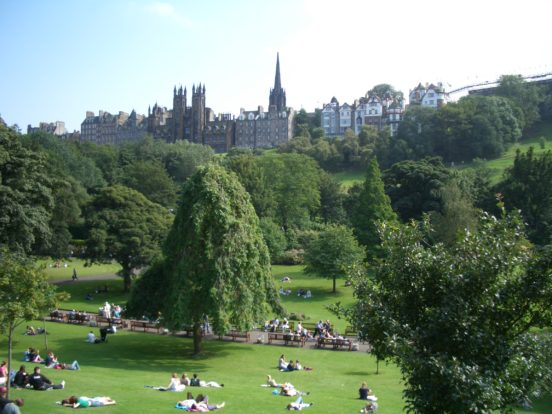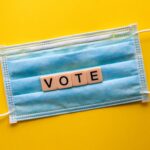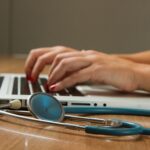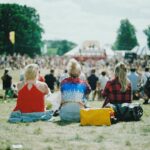Last weekend I received a letter from the Scottish Government, dated 18 May 2020, stating: “The NHS has identified you… as someone at risk of severe illness if you catch Coronovirus…. “It softens the blow by initially outlining how the government will be offering support during this period, before stating (bolded and underlined) “The safest course of action is for you to stay at home at all times and avoid face-to-face contact until at least 18 June”. This letter, to those in the highest risk group, is for our own protection and this action “will protect you from coming into contact with the virus, which could be very dangerous to you”.
In this short essay I reflect from the position of being placed by the Scottish Government in a vulnerable risk category and at risk of severe illness should I catch coronavirus. It is also informed by my background as a medical anthropologist and many years researching and writing critically on infectious diseases and their control. As a heuristic device I pose the question as to why I should adhere to the edict to stay at home as we move towards moving out of lockdown? Why should I trust the government, and the scientific advice, upon which this decision is made? In short, infectious disease outbreaks are always social and political, and their control by necessity involves sacrifices to be made in the name of the collective good. I do not dispute this. But we do need more visibly public debate into the ethics and politics of who bears the burden of the sacrifices, and one that takes to heart questions of social and economic inequalities
The letter provided a list of things to do to stay safe:
- DO STRICTLY AVOID contact with anyone who is displaying symptoms of coronavirus
- DON’T leave your home
- DON’T attend any gatherings
- DON’T go out for shopping, leisure or travel
This was followed by a list of dos – wash hands; keep in touch with medical services; and use remote technologies. The rest of my household, in addition, is affected as I should also ‘minimise the time I spend with others in shared spaces’; aim to keep two meters away from others; use separate towels, or if possible, a separate bathroom; and avoid using the kitchen when others are present; eat alone; and “if the rest of your household are able to follow this guidance to help keep you safe, there is no need for them to wear any special medical clothing or equipment”.
This is the first time I have received such a letter, and my reaction has been mixed. I have already read extensively around the rare medical condition I have – as a responsible “sanitary citizen”, that is my understandings of the body and health are inline with modern medical ideas that allow me access to the civil and social rights of citizenship – and weighed the potential risks that I may face from being infected from coronovirus. I am well aware of the potential drain to the NHS that I might become should I be ill. I am fortunate in being medically trained and as a social scientist I am able to read and interpret a wide range of scientific evidence. The condition I have is rare enough that the effects of coronavirus on those of us with it cannot be known yet with any statistical certainty, as the numbers required for the evidence is just not there. And from mid March, I have already had symptoms of coronavirus infection and was self-isolated, and quite ill for nearing a month, while fortunately avoiding hospital (I had considerable assistance over the phone from specialist NHS health professionals). I do not know for certain if I was infected because the policy at the time was to test for the presence of the virus only in those who were admitted to hospital.
Since recovering I have been exercising strict social distancing, exercising in the local park (this once daily trip out was keeping my anxiety levels at bay, and has become very important), but not entering into shops (unless absolutely necessary) or any other public space while out. I am fortunate in that I am able to work from home, have not been placed on furlough, and have a job that for the time being should be secure. Unlike so many others, my privilege means I do not have to physically put my body on the line and to place myself in potentially risky situations to maintain insecure income.
My reaction therefore is more ambiguous than thankfulness to a protecting and caring government. Why, then, should I adhere to these social segregation edicts that I have been on the receiving end of?
Firstly, the letter makes me feel as if I am personally responsible should I become infected (again?). The subtext is clear: It will be (partially, at least) my fault should I become ill. There seems no reflection on social determinants or inequalities, and all situations and contexts are placed on an equal footing. It also seems to make me responsible for the distance that others in the household should maintain from me. Living as we do in a small flat, this is physically all but impossible. How did it come to pass that the vulnerable themselves have now been made responsible for maintaining their own health in a pandemic? Just beneath the surface of this letter I can sense the lines of blame opening up; that it will be my own fault if I get ill, and perhaps further, that we will be responsible for potentially infecting others should we not obey these prolonged lockdown restrictions. But context is vital: social and financial privilege allow access to greater space within which to isolate and shield. We are not all in this together in the same way.
Why, then, have I received this letter now? One interpretation is that I have been in this vulnerable risk group for months, but that the Scottish Government is so slow and bureaucratically inept that I have only just now received it. But this is, I think, ungenerous. The second interpretation, which I am more inclined towards, is that a) the category of highest risk has expanded – perhaps as understanding of the clinical effects of coronavirus have developed, and who therefore is, or is not, at risk – and that b) receiving this letter is also part of the strategy adopted by the Scottish Government for our exit to lockdown. As we now know, Scotland’s exit strategy has diverged from that of England’s and is one that is seemingly more cautious. Fears of a “second wave” and what this will mean to both the capacity of the NHS to cope, to say nothing of the rise in deaths that may entail are central to scientific and public thinking.
Responses to the pandemic have been based on modelling exercises that are only as good as the interpretative parameters and data that is entered into them (one good thing that this pandemic has facilitated is a greater debate in the public sphere on scientific logic). We are all living through an immense social experiment based on modelling – as our civil liberties, often hard fought for over years are eroded all in the name of saving lives – and as we are subjected to a range of unprecedented social interventions by the state into the lives of us all. At the heart of the response is an immense paradox: that on the one hand the precautionary approach of science (requiring evidence before recommending something, for example around various treatments for symptoms), has been sacrificed to the one area of science for which there is little evidence, that of modelling for the future. Human sociality is not governed by the logic of mathematics. Modelling can only be really proven right in retrospect, and that I suspect only with wilful cherry picking of the post facto ‘evidence’. But again, this in itself is not enough to prevent me from not self-isolating and shielding.
It seems to me that in Scotland the government is currently implementing the recommendations of a model dubbed by the press the “Edinburgh Position”, based on an article of modelling on an idea called “segregation and shielding” or S & S.[1] [2]Basically this model looked at:
“S&S strategy using a mathematical model that segments the vulnerable population and their closest contacts, the “shielders”. We explore the effects on the epidemic curve of a gradual ramping up of protection for the vulnerable population and a gradual ramping down of restrictions on the non vulnerable population over a period of weeks after lockdown”,
to quote from the abstract. They acknowledge that the model borrows from ideas of ‘cocooning’ infants with shielded adults who have been vaccinated – an odd comparator, given there is no vaccine yet – but there is no precedent for this approach in the literature. They go on:
“We show that the range of options for relaxation in the general population can be increased by maintaining restrictions on the shielder segment and by intensive routine screening of shielders.”
In short, it looks as if those of us who are vulnerable are being asked to stay indoors with restrictions to both us, and those around us, so that the rest of you – the non-vulnerable – can get back to the semblance of a normal life. Frame it however you wish, but we – those who for a variety of reasons of health have restricted movements already – are being asked to further sacrifice our freedoms for the non-vulnerable majority. Again, I don’t necessarily have a problem in doing this, but there are some further questions that I would like to have some clarity on. Is this the only option, or a compromise because of an initial response that failed to bring community transmission down?
Scotland has its own scientific advisory group on COVID-19, to “supplement” that of the UK government. The membership of this group is known to the public and is published on the government website[3]. They have clearly learnt from the fiasco that surrounded the early UK government and SAGE – and one named advisor in Scotland has been a ferocious public critic of how the UK government has responded to the pandemic. One of the authors of the “S & S” paper is also on the advisory group. There is a welcome broader range of expertise here, but noticeably absent is humanities representation. Where are the bio-ethicists? The historians? The medical sociologists? Representation from vulnerable groups? Why, in short, is the advisory group not more diverse?
Now it may be that the current strategy – and the letter I received – is not based on this proposed model (in which case I am happy to be corrected – although the principle of the concerns will remain the same). But my question to the advisory committee is this: was this paper specifically, and the approaches it suggests, discussed? If not, what approaches to coming out of lockdown were discussed? And what were the parameters for this discussion?
There is evidence to show that there is greater buy in to restrictive public health measures with serious and sustained community involvement, as the literature around the effected communities of both HIV and Ebola show. Has this evidence from the social sciences been discussed, weighed up, and considered? Or does community involvement get jettisoned for paternalism with the need to ‘save lives’ in a crisis? Have the pitfalls historically, of segregating and shielding in all but name – both colonial and post-colonial in multiple contexts – been discussed and considered?[4] The group is well represented by public health experts, so can I assume that the broader social determinants of health, and the impact on those asked to stay in lockdown so the remainder of the healthy population can adapt to the ‘new normal’ have been considered? Has the impact of further lockdown for the vulnerable, and their mental and physical wellbeing been discussed?
It is quite possible, of course, that all this was fully thought through with the ‘deep dive’ approach on shielding that occurred at the last meeting – whatever that means (the minutes of the meetings held of the advisory group tell us next to nothing of any substance)[5]. But why not show us the evidence, please, that it has been. It may be that I (and can I project into ‘we’ here?) would buy into segregation and shielding more if there was evidence to demonstrate that a broader range of positions has been considered. Personally, I need this, and assurance that we are not being placed at the mercy of an approach that is so blinkered to all but flattening curves and P values that there is little space for these other issues. The broader goals and principles of the Scottish Government’s framework for decision making suggest a “new normal” till a vaccine and potential treatments are available and in place[6]. This might be years away, and in the meantime, will this new normal involve myself, and others in my position in this high-risk category remaining segregated and shielded? What is the rationale for the June 18th cut off date? What are the thresholds that are behind this date, and what plans are in place should they not be met? I would feel better placed to trust the edicts if I was reassured that a broad range of the ethical and social consequences had been fully deliberated upon.
Ian Harper is a Professor of Anthropology of Health and Development at the University of Edinburgh. He was the founding Director of the Edinburgh Centre for Medical Anthropology and a co-founder of Anthropology Matters.
[1] https://www.wiki.ed.ac.uk/display/Epigroup/COVID-19+project?preview=/442891806/447360858/van%20Bunnik%20et%20al.%20SS%20manuscript%20050520.pdf
[2] For a fuller and critical engagement with this proposal see: Ganguli-Mitra A, Young I, Engelmann L et al. Segmenting communities as public health strategy: a view from the social sciences and humanities [version 1; peer review: awaiting peer review]. Wellcome Open Res 2020, 5:104 (https://doi.org/10.12688/wellcomeopenres.15975.1
[3] https://www.gov.scot/groups/scottish-government-covid-19-advisory-group/
[4] For more on these critical points see: Ganguli-Mitra A, Young I, Engelmann L et al. Segmenting communities as public health strategy: a view from the social sciences and humanities [version 1; peer review: awaiting peer review]. Wellcome Open Res 2020, 5:104 (https://doi.org/10.12688/wellcomeopenres.15975.1
[5] From the minutes of 14th May 2020: “The Advisory Group held a deep dive discussion on shielding, noting that the primary aim of the policy is to save lives but that shielding is very onerous for those being asked to isolate themselves completely for an extended period of time. The group noted the importance of making use of scientific knowledge to determine which groups are truly at highest risk. The group considered different approaches being taken to shielding internationally, noting a wide variation in approach. The group discussed that age is the strongest general risk factor, but that rare conditions by their nature may be difficult to accurately determine a level of risk for as they won’t show up in statistics”. (See: https://www.gov.scot/publications/scottish-government-covid-19-advisory-group-minutes-14-may-2020/ )
[6] “Recover to a new normal, carefully easing restrictions when safe to do so while maintaining necessary measures and ensuring that transmission remains controlled, supported by developments in medicine and technology”
“ With scientists around the world working on vaccines and treatments that are still potentially many months away, we need to find a way to live with this virus and minimise its harms. We need to ensure, that as far as we can, our children are educated, that businesses can reopen, and that society can function. But we must ensure that those things happen while we continue to suppress the spread of the virus”.
https://www.gov.scot/publications/coronavirus-covid-19-framework-decision-making/pages/2/










Comments by